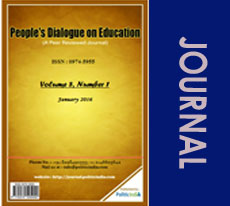The Game of Estimating Poverty Ratio Ashutosh Kumar
- Post By PoliticIndia.com on
- 2014-01-11 21:12:41
 Ashutosh kumar is M.A. & M.Phil. in Economics from JNU. Dy Director, CCI, New Delhi
Ashutosh kumar is M.A. & M.Phil. in Economics from JNU. Dy Director, CCI, New Delhi
Dandekar and Rath (1971) provided the first systematic assessment of the incidence of poverty. It was based on the National Sample Survey(NSS) data for 1960-61 using a cut-off level of expenditure that was adequate to provide 2250 kcals per capita per day both in rural and urban areas.Then in 1979, Planning Commission constituted a 'Task Force on Projection of Minimum Needs and Effective Consumption Demand' under the chairmanship of Prof. Raj Krishna. This task force estimated poverty line on the basis of nutritional requirements and recommended new poverty lines separately for rural and urban areas at national level. This committee defined the poverty line as per capita consumption expenditure level, which meets the average per capita daily calorie requirement of 2400 kcal per capita per day in rural areas and 2100 kcal per capita per day in urban areas along with a minimum of non-food expenditure. The Task Force used the 28th Round (1973-1974) National Sample Survey (NSS) data on household consumption both in quantitative and value terms in order to compute the monetary equivalent of these calorie norms. It was estimated that, on average, consumer expenditure of Rs. 49.09 per capita per month meets the calorie requirement of 2400 kcal per capita per day in rural areas, and Rs. 56.64 per capita per month with an intake of 2100 kcal per capita per day in urban areas.
All poverty lines were updated until the year 2004-05 on the basis of the above calorie norm by simply accounting for changes in consumer price indices. All India poverty lines updated for 2004-05 were Rs. 356.30 in rural areas and Rs. 538.60 in urban areas, per capita per month. In terms of per capita per day this poverty line will be 11.90 in rural areas and 17.95 in urban areas. This estimate of poverty line generated a number of controversies and regarded as destitution line by many economists.
Present Poverty Estimate by Tendulkar Committee
The Planning Commission in December 2005 appointed a Committee to review alternate concepts of poverty and recommend changes in the previous procedures of official estimation of poverty. The Committee was chaired by Late Professor Suresh D. Tendulkar, then Member of the Prime Minister's Economic Advisory Council (EAC) .The Committee submitted its report in November 2009.
The Committee identified three major limitations of the previous official poverty line. The first major weakness is that the consumption basket underlying the poverty line arrived in 1973-74 has become outdated. Second, the price indices which are used for adjustments have failed to capture fully the price rises resulting in underestimation of poverty. Finally, the existing poverty lines have not explicitly accounted for expenditure on health and education as they were expected to be provided by the state
The Tendulkar Committee suggested that poverty be estimated on the basis of consumption based on the cost of living index instead of caloric intake. It said that the basket of goods should also include services such as health and education. The new poverty line, as suggested by the Tendulkar Committee, is different for different states, and for rural and urban areas within a state.
Using the above method, the new poverty lines for 2004-05 have been re-estimated by the committee as Rs. 446.68 for rural areas and Rs. 578.80 for urban areas (per capita per month). In addition, the new Head Count Ratios( HCRs) for 2004-05 are estimated as 41.8 per cent in rural areas and 25.7 per cent in urban areas. These new estimates represent a significant upward revision of poverty in the rural areas, and a small downward revision of poverty in the urban areas. As per the new method, the total number of poor people in India has risen from about 403 million in 1993-94 to about 407 million in 2004-05.
The committee claims that it has arrived at a new poverty methodology which reflects marked improvements on four major counts. The improvements are: (i) unlike in the past the new poverty lines are detached from their underlying calorie norm; (ii) secondly, a uniform poverty line basket (PLB) is adopted for both rural and urban population based on the current consumption expenditure data; (iii) thirdly, there is a construction of new price indices which are primarily based on the unit prices of consumption expenditure survey; and (iv) lastly, there is an attempt to explicitly incorporate private expenditure on health and education in the price indices to account for their increasing role in determining household health and education status.
The new estimate is too far from reality, however the new poverty estimates is little more realistic than earlier estimate. Tendulkar committee raised the rural poverty line from about Rs. 12 to Rs. 15 per day. And in urban area this revision is from Rs. 18 to Rs. 19 per day. These meager are supposed to cover not only food but all non-food essentials, including clothing and footwear, cooking fuel, lighting, transport, education, medical costs and house rent. Even commonsense dictate that working health cannot be maintained, nor necessities obtained, by spending so little. The official poverty lines do not actually measure poverty but measure destitution.
Planning Commission periodically estimates poverty lines and poverty ratios for each of the years for which large sample surveys on household consumer expenditure have been conducted by the the NSSO. These surveys are generally conducted on quinquennial basis. The last quinquennial survey was conducted in 2009-10(NSS 66th round). Since 2009-10 was not a normal year because of severe drought, the NSSO repeated the large scale survey in 2011-12(NSS 68th round). The summary of the surveys is given in following table:
Table 1: Poverty Head Count Ratios (HCR %) on the Basis of Tendulakar Report
| Year 2004-05 | Year 2009-10 | Year 2011-12 | |
| Rural | 41.5 | 33.8 | 25.7 |
| Urban | 25.7 | 20.9 | 13.7 |
| Total | 37.2 | 29.8 | 21.9 |
Source: Planning Commission
Here in all three years, for estimation of poverty ratios, planning commission followed the Tendulkar's methodology. In year 2011-12 Planning Commission revised the monthly poverty lines and raised it to Rs. 1000 and Rs. 816 respectively for urban and rural areas respectively. This is equivalent to Rs. 33.3 and Rs. 27.2 per day. According to this estimates Head Count Ratios (or percent of Person Below Poverty Line) are 13.7 in urban areas and 25.7 in rural areas.
The official poverty ratios released by the Planning Commision shows a decline from 41.5 % to 33.8 % in rural India and from 25.7% to 20.9% in urban areas over 2004-05 t0 2009-10. And it further declined to 25.7 % and 13.7 % in rural and urban area respectively in year 2011-12.
Critical evaluation of the method of estimating official poverty line:
Many economist including Prof. Utsa Patnaik has criticised this official estimates and has shown that official poverty lines have cumulatively underestimated true poverty lines. Underestimation of poverty lines is the result of deliberate change in the definition of poverty lines. Government has been permitting access to a level of nutritional intake which is not constant but continuously declining over time, thus violating the definition of poverty line. The divergence between nutrition invariant (calorie norm) poverty lines and official poverty lines is the outcome of the Planning commission abandoning the original definition of poverty line and applying a different definition. The new estimation of poverty line is based on bringing forward the base year poverty line using a price Index. This method keeps the consumption basket fix at base year level and there by assumes that the same commodities are available in the later year as in the base year. Thus the definition of poverty line was delinked from the nutritional norm on the unstated assumption that indexation would preserve access to nutritional standards, but the assumption is rather incorrect. It can be explained below as:-
The Planning commission in practice gave up the calorie norm definition of poverty line which was adopted in 1973-74. After that, it has never looked over the next 40 years for actual current spending level for deriving poverty lines, even though NSS publish data on consumption expenditure on five yearly bases. The commission instead simply applied Price indices to bring forward the base year monthly poverty lines of Rs.49 rural and Rs.56 urban in 1973-74. In other words, Tendulkar Committee has price indexed the old poverty lines for estimating the new poverty line. For example if there is 300 percent price rise of consumption goods between these two periods and old poverty line is Rs.10 per day then the new line will be Rs.30 per day. Thus Tendulkar committee has simply altered the specific index.
But price indexation does not capture the actual rise in the cost of living over longer period, due to implicit limitation of construction of price index. This is explained by Prof. Patnaik by giving a very simple analogy- a fairly high level government employee getting Rs. 1000 a month in 1973-74 would get Rs. 18000 a month today if the salary was only indexed. But reality is an employee in the same position today gets salary of Rs. 70,000. It is so because indexing does not capture actual rise in cost of living. This is also recognized by government itself and this is the reason of appointing decadal Pay Commissions.
Official claims of decline in poverty level are not real and it is a result of mistaken method adopted by Planning Commission. According to Prof. Patnaik , by 2009-10, after meeting all essential non food expenses(manufactured necessities, utilities, rent, transport, health, education), 75.5 per cent of rural persons could not consume enough food to give 2200 calories per day, while 73 per cent of all urban person could not access 2100 calories per day. The comparable percentage for 2004-05 were 69.5 rural and 64.5 urban. These data are based on National Sample Survey (NSS) report. But official estimates show the poverty ratio of 41.8 and 25.7 percent in rural and urban areas respectively for year 2004-05. Why there is a difference between Official(Planning Commission) estimates and NSS data? Answer lies in mistaken method applied in measuring poverty line which is already discussed in preceding paragraphs.





